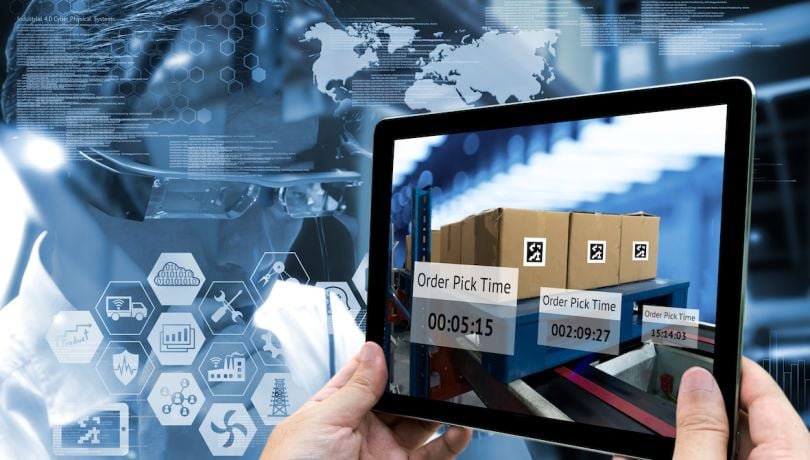Imagine this not-uncommon scenario: A ship travels across the Atlantic Ocean, carrying tubs of Brazilian oranges intended to be distributed at three centers in the United States. The journey across the water is long and choppy and, one night, a storm hits that destroys the shipment.
The supply chain planner is asleep during the storm. Hours pass before she wakes and reacts to the disruption, shuffling where and how new oranges will be sent to the distribution centers, and alerting partners later in the supply chain that an interruption has occurred. Time is money — keeping distribution centers waiting keeps oranges from supermarket shelves, and waiting to tell delivery teams how to react costs valuable time.
An increasing number of companies are deploying Internet of Things tech to automate these kinds of decisions, said Amit Gupta, a principal at KPMG consulting firm. This allows them to react immediately to interruptions and make decisions based on previously identified metrics or trends, he said.
“Not to say that you’re going to put your supply chains on cruise control and it’s going to make all the decisions for you, but there are many decisions that can be made in an autonomous fashion.”
“That’s not to say that you’re going to put your supply chains on cruise control and it’s going to make all the decisions for you,” Gupta said. “But there are many decisions that can be made in an autonomous fashion.”
In the case of the disrupted ship, an automated supply chain could prioritize sending a new bunch of oranges to the most profitable customer, Gupta said. Deploying IoT to make simple decisions not only saves time for the company but also the planner, he said, since she would then only need to focus on making decisions with high financial impact, or high impact to the supply chain.
One popular IoT company that many firms are using to track where their products are going is EVRYTHNG, a New York City-based firm that provides individual items with individual digital links. These unique identifiers are product-specific, and can track items’ origin, location, purchase history and marketing information. They can then organize this data into trends.
Companies are using Internet of Things tech like EVRYTHNG to spotlight how items get from one place to another, according to Abe Eshkenazi, CEO of the Association of Supply Chain Management trade group.
“We’re seeing the significant impact of IoT on feeding information to supply chain professionals,” Eshkenazi said. “We’re seeing just a massive increase in information and data. It’s challenging the other side of the supply chain activity — the workforce, and the competencies, and capabilities necessary to not only absorb the information, but to make it useful.”

What can digital links do?
Founded in 2011, EVRYTHNG assigns individual products with individual digital links, which can range from QR codes to radio-frequency identification (RFID) tags.
These tags can be scanned by consumers to find marketing information — shoppers who scan Mowi ASA’s tag will find recipes and information on how their salmon was raised, for example. Clerks that scan products tagged with EVRYTHNG labels in their point-of-sale systems will automatically order new items when their store is running low. Distributors in the beverage industry use EVRYTHNG for targeted recalls.
Dominique Guinard, cofounder and chief technology officer of the firm, said more than one billion products are assigned EVRYTHNG tags today. The firm counts 1.4 million transactions per minute.
Companies’ demand for the tech, Guinard said, is growing “very, very fast.”
EVRYTHNG builds its infrastructure in terraform, since the code is able to scale across multiple cloud providers, and uses a mix of SQL and no SQL servers to manage its humongous data needs. It also stores product and supply chain information in various blockchains.
These distributed ledgers — like IOTA, OriginTrail and BlockV — can be leveraged for brands to offer rewards programs and brand information. Their decentralized nature also lets companies choose what supply chain information they share with which partner.
“Today, the world of supply chains actually leverage the fact that there is some opacity. Full transparency is not necessarily something that’s wished.”
“Today, the world of supply chains actually leverage the fact that there is some opacity. Full transparency is not necessarily something that’s wished,” Guinard said. “There is very strategic data in supply chain data. Giving it completely away to everyone, your competitors or partners in the supply chain, would lead to different types of price negotiation, different types of stock negotiation.”

Creating a digital link standard
While most firms are hesitant to share blueprints for how they structure their tech, Guinard said standardizing digital links was key for it to grow across the marketplace.
About two years ago, Guinard approached GS1, a supply chain standardization firm best known for institutionalizing the bar code system. Guinard chaired a committee — made up of officials from Walmart, Unilever, Abbott Laboratories and others — bent on ordering how unique links for individual products were built.
Guinard was motivated to standardize digital links to increase uptake of his product. Others wanted to condense the number of barcodes used on a single item.
Before digital links, companies were unable to represent both the product ID used in the supply chain, and the marketing materials meant for consumers, under a single barcode. Using multiple barcodes introduced scanning errors in the supply chain. One glaring error at the time: Cowboy hats intended to end up in Austin ended up in Boston. In July of 2018, GS-1 adopted a digital link standard capable of representing both items of information.
Now firms like the Oregon-based Digimarc are offering the tech too.
“That’s when the magic kicks in. That’s when consumers start to know how to use these identities,” Guinard said. “That’s when, in the supply chain, you can use the identities in a uniform way.”

How IoT works in company supply chains
Companies have been using RFID tags to track products for at least 20 years, Gupta said. Major first-use cases began in the elevator and home appliance industries. These tags were able to sense an object’s condition and location but weren’t able to combine consumer marketing and supply chain information.
They also weren’t able to provide analytics on how items performed in the market.
“Where is the product being requested, who’s demanding it, what are the types of customers that are using the product?”
“You can get a lot of data about the demand patterns — about where is the product being requested, who’s demanding it, what are the types of customers that are using the product?” Gupta said of the digital links.
He said he expects digital link tags to soon be added to luxury, higher-priced goods. And in about five years, once the price of the tags drops, he said he expects to see them on smaller, lower-priced consumer goods too. He said he’s following the standard of Moore’s Law for cues on when we’ll see digital links in the marketplace, everywhere. (The standard basically states that, every two years, as computer processing speeds double, the price of the device is halved.) We won’t see digital link tags everywhere until they get cheaper to use.
“The cost for tagging has to go down to pennies, if not less than a penny per item,” Gupta said. “The technology hasn’t quite reached its peak yet.”

What happens when you open up your supply chain
When organizations take the time to examine where their products come from they sometimes learn disappointing things.
A pharmaceutical company may find out its ingredients don’t come from a sustainable source, Eshkenazi offered as an example.
What companies learn about their supply chains will challenge them to identify what information is critical for the consumer, and what is best kept behind the company firewall. Transparent supply chains also open up the opportunity for bad actors to exploit vulnerabilities in the system, Eshkenazi said.
Investment in cybersecurity will be a key trend for firms in 2020, Eshkenazi said. He said companies will also need to invest in training their workforce — and revamping their data infrastructures — to keep up with the advanced data collection and analytics systems deployed by firms.
“This is where the technology may challenge organizations to become much more aware of what is in their total supply chain.”




